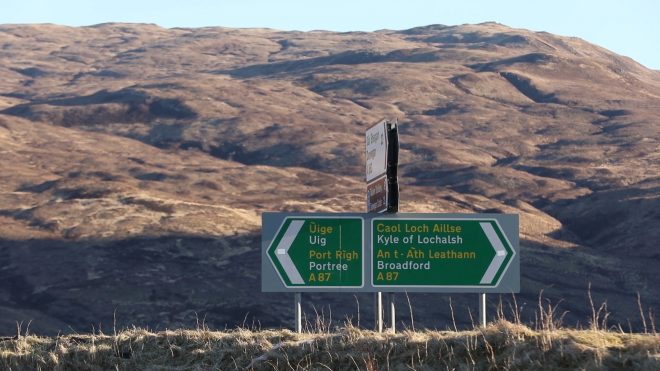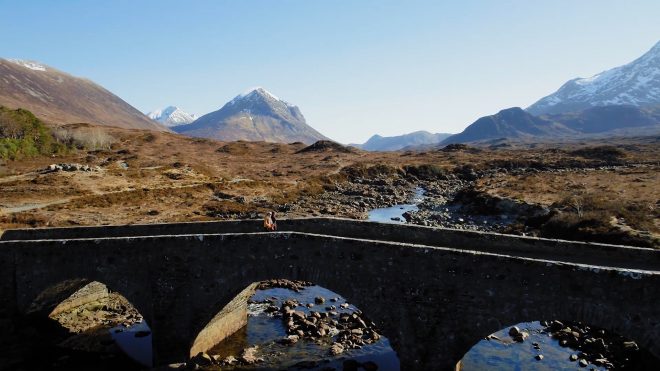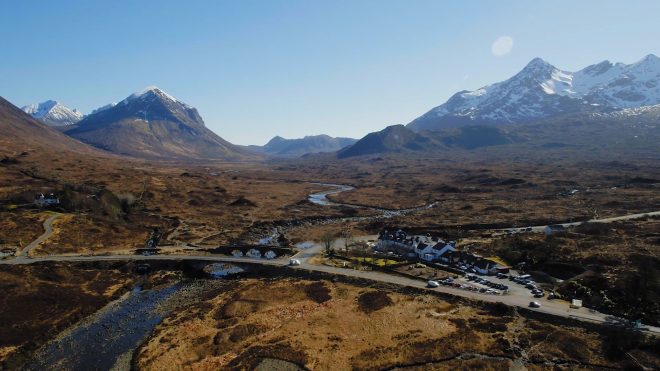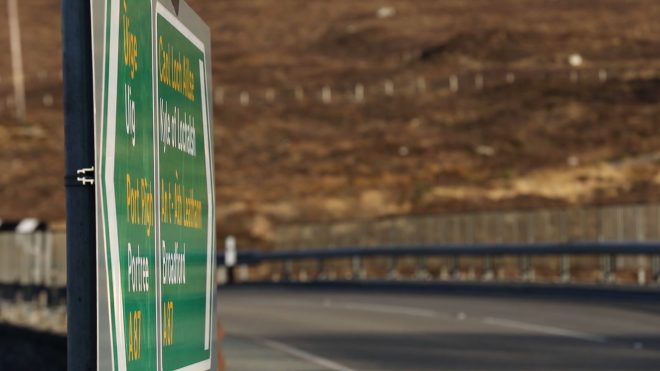‘These names introduce you to stories and cultures and traditions that are part and parcel of the people and the landscape of the west coast of Scotland’.
These are the words of singer Anne Martin, who I met in Skye a few months back to make a film about a bilingual Gaelic-English road sign collected by National Museums Scotland as part of our contemporary collecting programme.
For Anne, who lives in the north of Skye, these signs now punctuate her everyday life. The same is true for people across the north-west region. Even if you don’t live in the area, you’re likely to be aware of them in some way. You might have seen them while travelling or read about them in the news.

While bilingual road signs have existed in Scotland for decades, since 2010, as part of Scottish Government policy, all existing English road signs on trunk roads across the north-west region have been replaced with bilingual versions. For the Museum, the sign provides an object that relates to the physical impact of legislative change, part of our work in documenting life in 21st century Scotland.
But the sign offers more than that. It opens up ways of exploring what the Gaelic language means to people in Scotland now, in the 21st century. It helps us mark what is different about Scotland, and underline regional differences within and across Scotland. As Anne says in the film, ‘languages and cultures are diverse’.
Languages are living things that constantly evolve. For native Gaelic speakers like Anne, these signs mark the place names as they are known locally. As Eilidh Sgaimel of Gaelic Place Names of Scotland points out, they are also a visual representation of the language that we don’t often see around us in written form.
As anyone who is familiar with the language will know, Gaelic place names are hyper-descriptive. In this respect, the language has a distinct relationship with the Scottish landscape. Landscapes, and the markers within them – place names, man-made landmarks, natural features, archaeological sites – hold communal memories. In this way, Gaelic place names offer a way of understanding the lay of the land and the stories embedded within that land.

The road sign we have collected is a version of one from the very centre of the Isle of Skye, located by the Old Bridge over the River Sligachan – a place which has long been associated with folklore, myth and magic. The spot is popular with tourists today. The sign directs us to the Kyle of Lochalsh on the Scottish mainland and to the village of Broadford, a village further south in Skye. Both place names reference waterways. ‘Kyle’ means ‘narrow strait’, Loch speaks for itself while the ‘alsh’ or ‘Aillse’ is thought to reference the appearance or behaviour of the ground around the loch, describing moisture – a kind of sweatiness. Broadford is from Old Norse Breiðafjorðr ‘broad fjord or forth’.
In a museum display of the future, this sign can tell our visitors– from Scotland and across the world – layered stories about language, landscape, and about the way we navigate the world around us in Scotland today.
With thanks to Transport Scotland for donating the sign, and to Anne Martin and Eilidh Sgaimel (Gaelic Place Names of Scotland, Sabhal Mòr Ostaig).
Collecting the Present explores how our collection reflects changes in Scottish identity and the way the past is understood.
You can find out more about the series at www.nms.ac.uk/collectingthepresent
A’ Cruinneachadh na th’ Ann An-dràsta: Soidhne-rathaid Gàidhlig is Beurla
‘Tha na h-ainmean seo gad thoirt gu sgeulachdan is dualchas is dùthchas a tha mar dhlùth is inneach de mhuinntir agus de chruth-tìre taobh an iar na h-Alba’.
Seo briathran an t-seinneadair Anna Mhàrtainn, ris an do choinnich mi san Eilean Sgitheanach beagan mhìosan air ais a dhèanamh film mu shoidhne-rathaid Gàidhlig is Beurla a thog Taighean-tasgaidh na h-Alba mar chuid den chlàr againn gus rudan a bhuineas don latha an-diugh a chruinneachadh.
Do dh’Anna, a tha a’ fuireach ann an ceann a tuath an Eilein, tha na soidhnichean seo ann an teis-meadhan a beatha bho latha gu latha. Tha sin fìor mu dhaoine a tha a’ fuireach air feadh ceann an iar-thuath. Fiù ‘s ged nach biodh tu a’ fuireach anns an sgìre, ‘s dòcha gum bi thu mothachail orra ann an dòigh air choreigin. Math dh’fhaodte gum faca thu iad fhad ‘s a bha thu a’ siubhal no gun do leugh thu mun deidhinn sna naidheachdan.

Ged a tha soidhnichean dà-chànanach air a bhith ann an Alba fad bhliadhnaichean, bho 2010, mar chuid de phoileasaidh Riaghaltas na h-Alba, thathar air a h-uile prìomh-rathad anns a’ cheann an iar-thuath a thoirt air falbh agus dreach dà-chànanach a chur nan àite. Don Taigh-tasgaidh, tha an soidhne na nì a chuireas an cèill a’ bhuaidh chorporra a bheir atharrachadh air reachdas, buinidh cuid den obair againn ri dealbh a thoirt den t-saoghal ann an Alba san linn sam beò sinn.
Ach tha barrachd air sin an lùib an t-soidhne. Tha e a’ fosgladh dhòighean gus eòlas a chur air brìgh na Gàidhlig do dhaoine ann an Alba an-dràsta, san 21mh linn. Tha e cuideachadh rinn a chomharrachadh na tha fa leth a thaobh na h-Alba, agus gus cuideam a chur air diofaran eadar roinnean air feadh na h-Alba. Mar a tha Anna ag ràdh san fhilm ‘tha cànanan is dualchas eugsamhail’
Tha cànanan nan nithean beò a tha ag atharrachadh fad na tìde. Airson muinntir na Gàidhlig leithid Anna, tha na soidhnichean seo a’ comharrachadh nan ainmean-àite mar a dh’aithnichear gu h-ionadail iad. Mar a tha Eilidh Sgaimeal bho Ainmean-àite na h-Alba ag ràdh, tha iad cuideachd nan riochdachadh lèirsinneach den chànan nach fhaic sinn gu tric timcheall oirnn ann an cruth sgrìobhte

Mar a bhios fios aig a h-uile duine a tha eòlach air Gàidhlig, tha ainmean-àite Gàidhlig nan dealbhan dha-rìribh. A thaobh seo, tha càirdeas dha-rìribh aig a’ chànan ri cruth-tìre na h-Alba. Tha cuimhne an t-sluaigh ann an cruth na tìre agus sna comharraidhean nam broinn – ainmean-àite, comharran-tìre a thog mac-an-duine, cruthan, làraichean-àrsaidheachd. Tha ainmean-àite nan dòigh gus suidheachadh an fhearainn agus na sgeulachdan an lùib an fhearainn sin a thuigsinn
Tha an soidhne-rathaid na dhreach de dh’fhear a thog sinn am meadhan an Eilein Sgitheanaich, faisg air an t-Seann Dhrochaid thar Abhainn Shligeachain – àite a bha ceangailte riamh ri sgeulachdan is draoidheachd. Tha fèill mhòr aig luchd-turais air an àite an-diugh. Tha an soidhne gar treòrachadh gu Caol Loch Aillse air tìr-mòr na h-Alba agus don Àth Leathann ann an ceann a deas an Eilein. Tha iomradh air uisge anns an dà ainm-àite. Tha ‘Caol’ a’ ciallachadh ‘caolas’ gun tighinn air an fhacal ‘Loch’ agus thathar den bheachd gu bheil ‘Aillse’ a’ toirt tarraing air cumadh no giùlan an fhearainn mun loch, far a bheilear a-mach air taise – seòrsa de dh’fhallas. Is e an t-Àth Leathann riochd na Gàidhlig den ainm Broadford a tha a’ tighinn bhon t-Seann Lochlannais Breiðafjorðr’
Ann an taisbeanadh ann an taigh-tasgaidh san àm ri teachd, innsidh an soidhne dhan luchd-tadhail againn – à Alba agus às an t-saoghal mhòr gu lèir – sgeulachdan air muin a chèile mu chànan, mu chruth-tìre agus mun dòigh sam bi sinn a’ seòladh san t-saoghal mun cuairt oirnn ann an Alba an-diugh.
Le buidheachas do Chòmhdhail Alba a thug an soidhne seachad, agus do dh’Anna Mhàrtainn is Eilidh Sgaimeal (Ainmean Àite na h-Alba, Sabhal Mòr Ostaig).
Th Cruinneachadh na th’ Ann An-dràsta a’ rannsachadh mar a nochdas an cruinneachadh againn atharrachaidhean air ìomhaigh na h-Alba agus air an dòigh sa bheilear a’ tuigsinn na h-ùine a chaidh seachad.
Gheibh thu a-mach barrachd mun t-sreath aig www.nms.ac.uk/collectingthepresent
